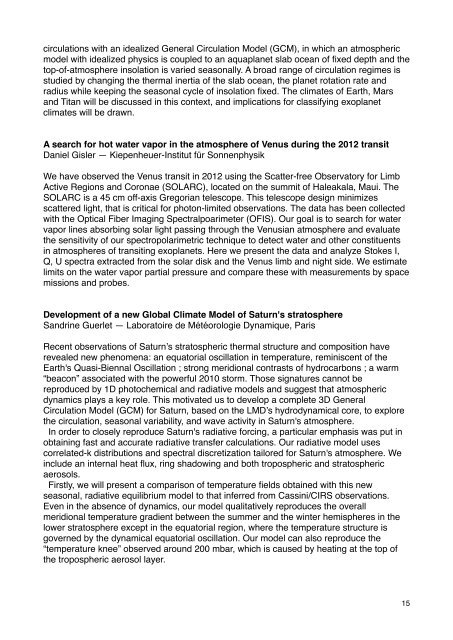Exoclimes_Conference_booklet1
Exoclimes_Conference_booklet1
Exoclimes_Conference_booklet1
You also want an ePaper? Increase the reach of your titles
YUMPU automatically turns print PDFs into web optimized ePapers that Google loves.
circulations with an idealized General Circulation Model (GCM), in which an atmospheric<br />
model with idealized physics is coupled to an aquaplanet slab ocean of fixed depth and the<br />
top-of-atmosphere insolation is varied seasonally. A broad range of circulation regimes is<br />
studied by changing the thermal inertia of the slab ocean, the planet rotation rate and<br />
radius while keeping the seasonal cycle of insolation fixed. The climates of Earth, Mars<br />
and Titan will be discussed in this context, and implications for classifying exoplanet<br />
climates will be drawn.<br />
A search for hot water vapor in the atmosphere of Venus during the 2012 transit<br />
Daniel Gisler — Kiepenheuer-Institut für Sonnenphysik<br />
We have observed the Venus transit in 2012 using the Scatter-free Observatory for Limb<br />
Active Regions and Coronae (SOLARC), located on the summit of Haleakala, Maui. The<br />
SOLARC is a 45 cm off-axis Gregorian telescope. This telescope design minimizes<br />
scattered light, that is critical for photon-limited observations. The data has been collected<br />
with the Optical Fiber Imaging Spectralpoarimeter (OFIS). Our goal is to search for water<br />
vapor lines absorbing solar light passing through the Venusian atmosphere and evaluate<br />
the sensitivity of our spectropolarimetric technique to detect water and other constituents<br />
in atmospheres of transiting exoplanets. Here we present the data and analyze Stokes I,<br />
Q, U spectra extracted from the solar disk and the Venus limb and night side. We estimate<br />
limits on the water vapor partial pressure and compare these with measurements by space<br />
missions and probes.<br />
Development of a new Global Climate Model of Saturn's stratosphere<br />
Sandrine Guerlet — Laboratoire de Météorologie Dynamique, Paris!<br />
Recent observations of Saturn’s stratospheric thermal structure and composition have<br />
revealed new phenomena: an equatorial oscillation in temperature, reminiscent of the<br />
Earth's Quasi-Biennal Oscillation ; strong meridional contrasts of hydrocarbons ; a warm<br />
“beacon” associated with the powerful 2010 storm. Those signatures cannot be<br />
reproduced by 1D photochemical and radiative models and suggest that atmospheric<br />
dynamics plays a key role. This motivated us to develop a complete 3D General<br />
Circulation Model (GCM) for Saturn, based on the LMD’s hydrodynamical core, to explore<br />
the circulation, seasonal variability, and wave activity in Saturn's atmosphere.<br />
In order to closely reproduce Saturn's radiative forcing, a particular emphasis was put in<br />
obtaining fast and accurate radiative transfer calculations. Our radiative model uses<br />
correlated-k distributions and spectral discretization tailored for Saturn's atmosphere. We<br />
include an internal heat flux, ring shadowing and both tropospheric and stratospheric<br />
aerosols.<br />
Firstly, we will present a comparison of temperature fields obtained with this new<br />
seasonal, radiative equilibrium model to that inferred from Cassini/CIRS observations.<br />
Even in the absence of dynamics, our model qualitatively reproduces the overall<br />
meridional temperature gradient between the summer and the winter hemispheres in the<br />
lower stratosphere except in the equatorial region, where the temperature structure is<br />
governed by the dynamical equatorial oscillation. Our model can also reproduce the<br />
“temperature knee” observed around 200 mbar, which is caused by heating at the top of<br />
the tropospheric aerosol layer.<br />
15


